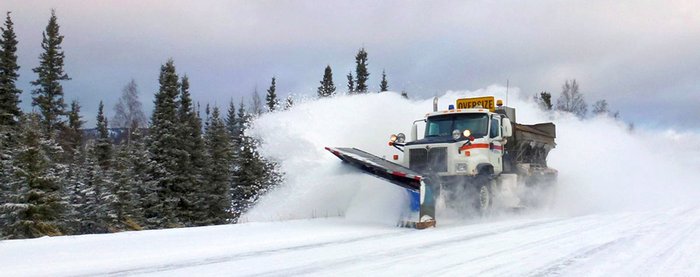

Nick Herman from Delta plows snow on the Alaska Highway. Photo by Dennis Bishop, ADOT&PF
How ADOT&PF Approaches Ice and Snow Removal Nov. 4, 2015
A common question we hear from residents after a big winter storm is “When will road ‘X’ be cleared?” There are several factors that determine how soon we can remove ice and snow from a roadway. Here’s a look at some of the biggest factors.
Road Priority Levels
The Alaska Department of Transportation and Public Facilities follows a systematic approach to clearing roads of ice and snow. We categorize each road we maintain as one of five priority levels. Each level is based on traffic volume, speed, and connections to communities and other roads within the local transportation network.
Priority 1 roads receive the most winter maintenance, followed by Priority 2, Priority 3 and, finally, Priority 4. Priority 5 roads do not receive winter maintenance. In communities without Priority 1 roads, staff will begin by clearing the Priority 2 roads or whichever roads are of highest priority within the district. The five priority levels are defined as:
- Priority Level 1: high-volume, high-speed highways, expressways, minor highways, all safety corridors and other major urban and community routes.
- Priority Level 2: routes of lesser priority based on traffic volume, speeds and uses. Typically, these are major highways and arterials connecting communities.
- Priority Level 3: major local roads or collector roads located in larger urban communities.
- Priority Level 4: minor local roads that provide residential or recreational access.
- Priority Level 5: roadways that are designated as “No Winter Maintenance” routes, e.g. Denali Highway or Taylor Highway.
To find out what a road’s priority level is, visit our online Winter Road Maintenance Priority Map at dot.alaska.gov/wintermap.
Severity of storm
Residents should expect snow and ice removal after major weather events to take more time than in the past.
We schedule our maintenance staff to cover seven days a week and holidays, but budget cuts mean we have fewer employees and less equipment available to respond after a snowfall or freezing rain.
When major storms hit, we will focus on higher priority roads (Levels 1 and 2). Residents living off lower priority level roads can expect it to take longer for their roads to be cleared. We ask residents to be patient with us as we work to keep Alaska’s roads safe.
Previous Blogs
- Mailboxes and Snow
- Road Priorities for
Snow Removal - Reflectors
- Construction Manager/
General Contractor - Safe Biking
- Bicycles on the Road
- Update: Johansen Expressway
- Online Open House
- Wood Retrieval
- Iditarod Restart
- Parks Highway 2015 Projects
- Super Open House 2015
- Damalanche
- Speed Limits
- REDDI
- Winter Pedestrian Safety
- Driveway Snow Removal
- Safe Winter Driving
- Public Involvement Calendar
- Public Involvement
- Salt Brine 101
- Traffic Counters
- Traffic Detection
- Welcome Blog
